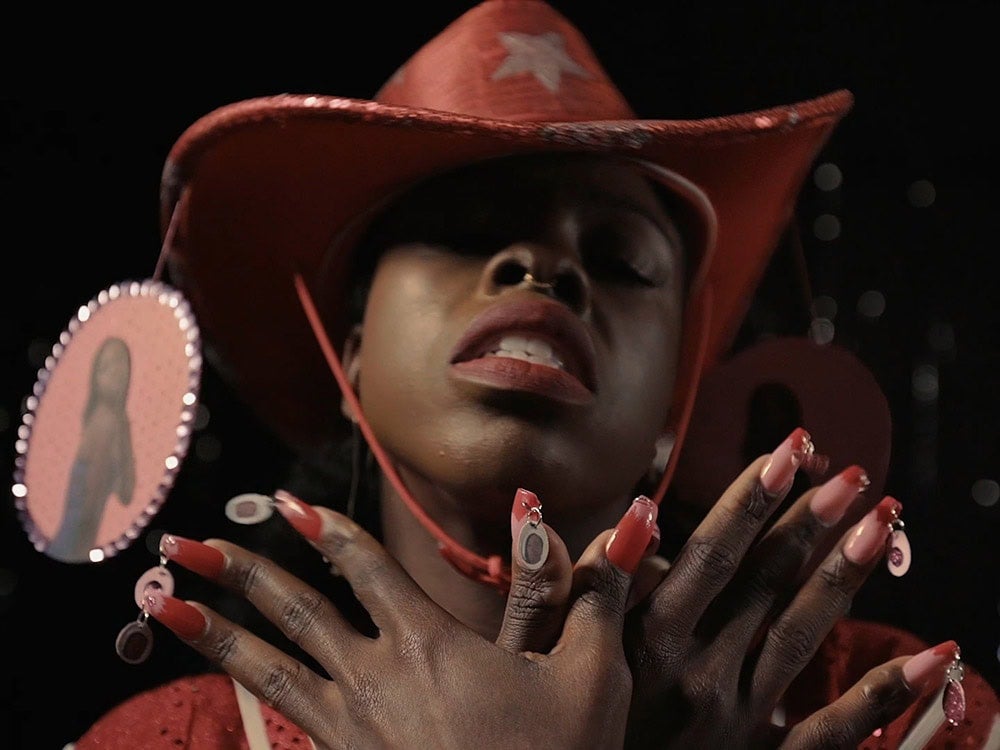
“We are here to honor our dead,” intones an offscreen voice over a scene of a jumping man enmeshed in a net of clattering skulls. Keisha Rae Witherspoon’s remarkable short film T (2019) begins at the annual ball from which it takes its title, a jaunty celebration in Miami that memorializes the dead. T follows a trio of the bereaved as they ready themselves for the occasion. It’s that familiar kind of Black ritual—sown in mourning, it flowers in joy. The performers dance, twirl, and strut, flaunting their elaborate costumes and their commemorative T-shirts bearing the faces of their beloved. They are shimmering, mysterious, veiled.
The film wears a veil, too. That veil is exquisitely woven in a style that swathes fiction in documentary. The conventions of the latter are all here, but Witherspoon wields them to astonishing ends. The action draws a mesmerizing force from this conceit, which is most deeply felt in the shaky relationship between the camera and the subjects. (Or should we say characters?) Witherspoon’s camera seems slung around their whims. They share the role of director.
Dimples, a vivid, vivacious seamstress, beckons us into her living room, the walls decorated with her late son Jasper’s childhood artworks. Stately in blue, wrists wrapped in bangles, neck adorned with a golden Eye of Horus, she ushers us through her domestic gallery: his “experimental phase,” his preoccupation with masks, a sprawling flag. Jasper loved chips, so Dimples is at work on a costume fashioned from the silvery insides of various chip bags, a costume she ruefully senses might amuse him.
Cut to young Tahir. His voice is coated in the metallic grain of a robotic vocal effect. His late twin sister, Isis, loved “eighties rock, comic books, and alchemy,” he relates as he clicks through a reel of her pictures. They had a shared obsession with binaries, with red and blue. The footage is intercut with an uncanny array of images in those colors, as if searching for something that matches the intensity of their fascination: police lights, a red and blue pill, a map of the US, an anatomical diagram.

Ash is charismatic and playful. “Welcome to African-America!” he shouts, before beating a plastic drum. Throughout the film, his expression slides from sly smirk to beaming grin to stony reserve. He’s been tending to his greenhouse, his “produce section,” which yields scotch bonnet peppers, pineapples, and bananas. In the quiet afternoon, two boys, glowing with a Burnettian tenderness, linger before a fence.
Grief—Black grief—is so often seized by both arms, hauled onto some stridently lit stage, prompted to keen a dutifully plangent note, then summarily dismissed. Exit Black Grief. Shouts of bravo, cries of encore. Witherspoon knows all too well this performance, and so the characters repeatedly deflect and thwart the camera in their own ways. Dimples bars our entry into Jasper’s old bedroom: “You don’t come past here.” Tahir tells a long-winded joke that at last arrives at a boyish impertinence: “There’s no punchline, bitch!” And Ash is the most brusque, testily interrogating. “What y’all really wanna see?” he asks us, his face confronting the lens. At one point, he teasingly spits down at the camera, then mounts the side of a vintage blue Shelby Mustang, leaving us behind. How bracing to see Black people demur, withhold, refuse. And what a change of pace to watch the camera genuflect. We never learn the circumstances of the deaths of their loved ones. Why should we? Is it not enough to know they’ve suffered a loss?
At the ball, Tahir, looking like a sleek little Rammellzee in his robotic costume fitted with LED lights, dances with abandon. He takes firm, swift stomps, the red and blue flashing in the dark. The resonant score is especially entrancing here, as his slow motion movements dazzle the frame. Finally, he blurs into whirls of vibrating color that give way to the cosmos. Clouds of pink, purple, blue. I think of a refrain uttered by Noh performers in an Ozu film: “Only the color remains…”
After garnering prizes at last year’s New Orleans Film Festival, Keisha Rae Witherspoon’s T (2019) screened at the 2020 Sundance Film Festival and won the Golden Bear for Best Short Film at the Berlin International Film Festival in February.




